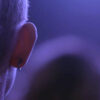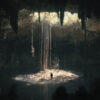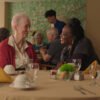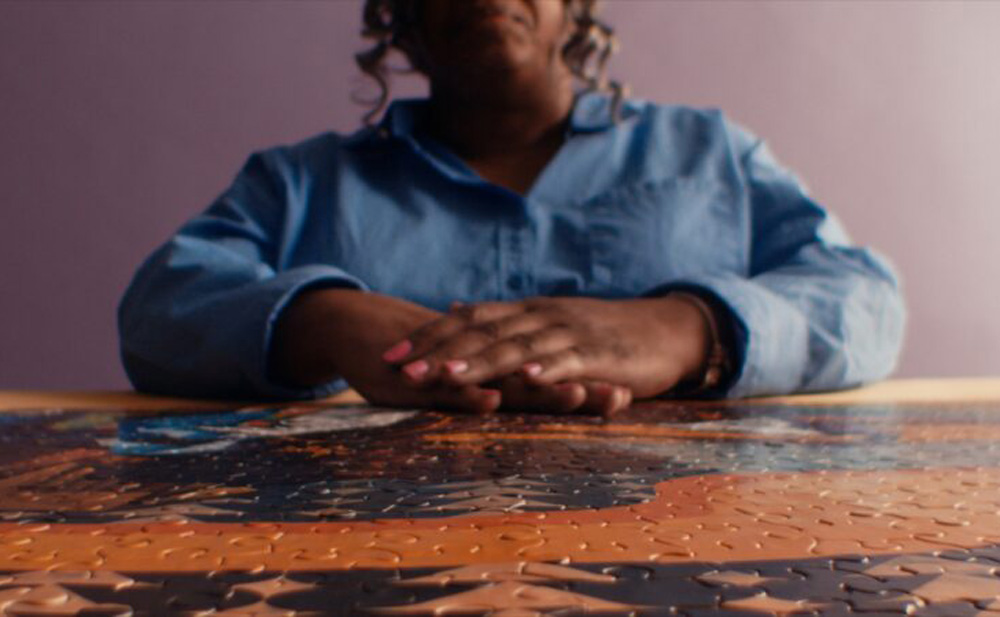After Emily Sheskin followed the boxing prodigy Jesselyn Silva for her debut feature “JessZilla,” she wasn’t necessarily looking for inspiration to carry on when there was as much of it in Silva’s story as the boxer could pack into a punch, but she was looking for something a little lighter, literally.
“We had been at the mercy of so many event centers and random gyms [for my last film], and I looked at [my producer Ben Kainz] and I was like, ‘You know, I just want to do something really joyful and happy and colorful,’ Sheskin recalls.
The filmmaker couldn’t have been led to anyone more incandescent than Adele Tiffith, who has brightened up the lives of many from her home by live-streaming herself putting puzzles together. One of nine children, Adele, better known online as GrandmaPuzzles, got into the group activity of piecing together jigsaw puzzles as way to bond with her family and eventually passed the tradition on when she had children of her own, but upon becoming an empty nester, she could keep doing the puzzles to keep herself busy, but was intrigued by the possibilities when she started watching her son play games on Twitch and other users in the chat started to take an interest in her.
“Who’s going to watch a senior citizen grandmother do jigsaw puzzles on a platform where people are competing, playing ‘War Zone’?” Adele wonders aloud in “Livestreams with GrandmaPuzzles,” Sheskin’s exuberant short profile of the playful granny, adding a new set of viewers to the one million live views a month that she can now reasonably expect on her feed nowadays after becoming an online sensation. When Adele is a colorful character all her own with a sharp sense of humor and a mind clearly attuned to putting together a bigger picture, Sheskin need not do more than gently accentuate the gregarious storyteller in front of her, with her natural glow radiating just a bit more by color coordinating her clothes and the backgrounds of her surroundings and inviting audiences in with the same warmth that Adele welcomes people of all types to watch her solve puzzles.
After premiering last fall at the Hot Springs, “Livestreams with GrandmaPuzzles” has become a favorite at festivals far and wide, stopping this week at Cleveland Film Festival and later this month at the Florida Film Festival, and the spring sweep coincides with another special moment for Sheskin as “JessZilla” is finally being made available on VOD and streaming in May, marking the end of a nearly decade-long effort for the director to bring Silva’s story to the screen after documenting what was ultimately a fight for her life as she contends with cancer. Both films showcase Sheskin’s considerable talent for finding people who find something special within themselves that they can share with the world and the director can amplify undiluted, making the joy she must’ve felt in their company infectious and hardly limited to her own experience of them. Recently, she graciously spoke about her approach in general as well as the more specific path she took to making “Livestreams with GrandmaPuzzles,” in addition to finding her way into becoming a stellar documentarian.
How did this come about?
Since you’re familiar with “Jesszilla,” you know that Jesselyn [Silva] got sick in the making of our film, which was very unexpected. We went into that looking to make a film around a champion and she is and at the same time, her fight became very different than what we expected. As we were finishing up the editing process, my producer Ben [Kainz], who also produced “Jesszilla” [said], “What are we doing next?” I started to look into speed puzzling, which I had no idea was a thing, and there’s a film called “Wicker Kittens,” which I watched as research because the scene has changed a lot since that film came out.
The pandemic really put puzzling on the map. When I watched it, I saw a familiar name at the end of the credits — Mike Scholtz, who is a friend of mine I met through the Fargo Film Festival. When I went with “Jesszilla,” I saw him and [said], “Mike, I’ve got to talk to you about this puzzle stuff.” It turns out his partner, Val, is the head of the USA National Jigsaw Puzzle Association and Mike was very much like, “Look, I am completely done doing movies on the puzzle community, but I love that for you. And if you do, I have a hot tip.” And that was Adele. He [told me], “This woman had come with her son to the speed puzzling,” and then I come to find out, she’s a Twitch celebrity. She was a comedian. She’s just a performer. She is so funny and warm. And I think everybody who watches her just falls in love with her. I watched some of her Twitch streams. It was like, “This lady is incredible.” Val helped get us in touch with her and then one thing led to another.
It looks like there’s a larger puzzle project in the works. Was this a gateway into that or something that you were able to see as a piece of it?
The feature process is obviously long and difficult and a lot of times you need to have a sample in order for people to really see the vision and get on board. But I didn’t want to spend money and make something only to show what this could be. I [thought], “Why don’t we just make a short film? She’s amazing. She can carry it.” That was my plan, and we had several days of shooting to make a short film around Adele and then we would have these other pieces for more of a work sample to pitch the feature.
You have a clearly defined style here, which was true of “Jesszilla” as well, though radically different when it was verite. What was it like doing something different?
A part of what I love about documentary filmmaking is the improvisational quality of it. You have to roll with the punches, no pun intended. At the same time, I come from a commercial background and I grew up watching a lot of narrative film, so I have a huge love of narrative cinema as well where things are meticulously planned. Miyazaki is one of my favorite filmmakers and he’s an animator, a master of the craft, and I was always thinking, what would it be like to be able to plan to that level? Obviously I couldn’t plan everything with this, but I went into this project wanting to do something whimsical and quirky. We did work with an art director who helped us think about a color palette and dream that stuff up, which is something I’ve done on my commercial jobs, but not necessarily in my indie life. And I thought, if Wes Anderson directed a documentary, what would it look like? Growing up, he was one of my favorite filmmakers, so this was my little love letter to those films through documentary.
It looks like the documentary work and commercial work you’ve done has been complimentary in some ways. I know many do the latter to be able to pursue the former, but was documentary something you were always interested in?
I went to NYU film school and I had a really amazing roommate, Veena Rao, a phenomenal filmmaker who I met when we did study abroad. Veena introduced me to documentaries. She was a photo and film major. And she would go to Kim’s and rent some documentary. This is in the early 2000s, and she’d be like, “Hey, you wanna watch this movie?” I would [say], “Sure.” And she really introduced me to a lot of documentary filmmaking. In those formative years, we did this thing called the International Documentary Challenge where you made a documentary in five days. That was where I really started to fall in love with documentary filmmaking because it was a lot of fun.
I was working as a commercial editor to pay the bills, and then Veena and I would go and make a documentary. As our careers progressed, we could take more time off and make longer things and eventually, we started to make our own work. I was always working in the commercial world and branded content became more of a thing that clients wanted, so I was positioned really well for that kind of work because I understood documentary filmmaking. When the “Girl Boxer” short came out in the New York Times, that was really when I was able to transition from a day job where I was an in-house editor, and then I would direct sometimes to being a director.
You’re obviously great at connecting with your subjects. What was it like to meet Adele?
What I immediately appreciated about Adele was she was just so transparent about and vulnerable about the struggles she’d had. That’s partially why I think the community loves her as much as they do is because she doesn’t sugarcoat things. When things are hard, they’re hard and she’s created a supportive space to help people get through whatever they’re going through. On Mother’s Day, which can be a difficult holiday if you’ve lost a maternal figure in your life or don’t have one, she will do a Mother’s Day puzzle-a-thon where you can come and she’ll be your mom or grandma. I thought that was really lovely and kind and sweet and part of why she has the success she has is because she is just that wonderful person that you see. It’s not an act. At the time we made the short, I think she had 16,000 followers and now she has 25,000. So that community continues to grow and what’s incredible is in a world where it feels like things are getting more and more polarized and people are not nice online, she has this very kind corner of the internet. It’s a beautiful, beautiful thing.
She’s obviously such a vivacious person who can carry a film on her own. Was it obvious to have her exclusively tell her own story when I imagine you could’ve done other interviews?
The way that I tend to work is I don’t feel comfortable dictating somebody’s story. What we do is we chat. I tend to have a conversation with whoever I’m potentially going to be working with just to see if it makes sense, if it’s a good fit where they’re able to ask questions and be an active participant, so by the time we sit on and step onto set, they’re a partner in our filmmaking process. I feel like I get to know them and [Adele] had been really open and transparent about her struggle with depression and loneliness. This is something a lot of seniors deal with as they get older, if they have health issues and they’re more isolated and part of why I was attracted to this was because we’re talking about depression and loneliness and we’re facing it head on. But the solution in her case was really interesting and unexpected and it was just my job to capture that in a way that felt authentic to her.
There are two puzzles put together in the film, both of which are quite eye-catching in their own ways – you actually have some family pictures in one, which is a great way to illustrate the backstory, and then there’s a beautiful painting in the other. How did you end up with those as set-pieces?
First of all, we knew how important her family was and every filmmaker is trying to handle archival in the best way possible. I thought if we’re doing something on puzzles, every archival photo should be a puzzle and we asked [Adele] for these photos ahead of time because she had talked about her children. So I said, “Let’s get these photos and surprise her with this.” She was so excited and she did that puzzle. And Adele had introduced us to Jaleel Campbell, the artist of those beautiful puzzles [one of which you see in the film], because when we were talking to her on that initial phone call,she talked about how there isn’t a lot of Black representation in the puzzle space and that’s really important to her. She’s introduced us to a bunch of incredible puzzle artists and Jaleel was one of them. We wrote to him specifically just to get permission to use his images and he was like, “Anything to support Grandma.” And everybody that we wrote to, they’re just like, “Yeah, if it’s for Grandma, absolutely.” It just speaks to the space, the community, and everything that she’s doing.
The music is also a really buoyant and lovely part of this. What was it like to put a score on this to match Adele’s energy?
Pietro Milanesi is a phenomenal composer. We were lucky to work with him on “Jesszilla” as well, and I am not a musically inclined person, so the way that we worked together was I talked about the emotion and the themes and what I was thinking and he somehow managed to translate my word salad into like these beautiful compositions. So when I said, “Hey Pietro, I have something new, and I’m thinking a bit whimsical,” he just nailed it. I’m very grateful to be working with him and putting that track on for the first time just brought it to life in a way that any temp track just doesn’t hold a candle to.
What’s this period been like? You’ve been traveling a bit with “Livestreams with GrandmaPuzzles” and I understand “Jesszilla” is about to be available to the masses on VOD soon.
Any time you make something, it has a life that you can’t control. I made [“Livestreams with GrandmaPuzzles”]. I thought it was delightful and I sent it to my mom, who is actually a tough critic, and she thought it was delightful. So it’s like, “Okay, we’re off to a good start,” and bringing it to Big Sky [recently] and seeing it there with an audience, the thing is when you’re at a film festival, if you’re like me, sometimes approaching people can be it’s not the most comfortable thing. I’m not a schmoozer in that way, but to be able to be like, “I’m Emily. I made ‘GrandmaPuzzles,’ immediately people were like, “Oh my gosh, we love her. Tell us more.” So it’s been a great icebreaker. It’s been amazing to see how much people love it and it’s amazing how many people have their own puzzle stories and how puzzling has become this cultural thread that connects so many of us. So it’s just been a lot of fun and I’m excited to continue keep the good times rolling.
And we’re really excited to get “Jesszilla” to audiences too because that film has been like 10 years in the making at this point. We just partnered with the World Boxing Council and with Cure, a childhood cancer charity and we’ve raised over $20,000 in Jessalyn’s memory to have the Jessalyn “Jesszilla” Silva Fund where all the proceeds are going to brain cancer research and support families. So it’s been really wonderful to see the impact that that film is really getting to have now as we’re coming to another finish line.
“Livestreams with GrandmaPuzzles” will screen at the Cleveland Film Festival as part of Shorts Program 10 on April 2nd at 11:55 am at the Allen Theatre. It will also be available virtually as part of CIFF Streams from April 6th through 13th.




